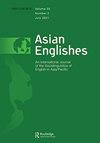Insertion of the voiceless fricative [s] at word-final position in Japanese English
IF 1.8
Q1 LINGUISTICS
引用次数: 1
Abstract
ABSTRACT This article explains how the voiceless fricative [s], or what we refer to as ‘special [s],’ occurs in free talk produced by Japanese speakers of English and what this means for the current understanding of Japanese English. The discussion is based on a small corpus compiled by the authors from recordings. The findings are threefold. The special [s] is always voiceless, occurs only word-finally, and arises from four different pragmatic forces. These forces are discourse marker, hesitation, cause and effect, and expression of self. The definition of Japanese English has been built heavily on the influence of the first language (L1) on the second language (L2). While L1 transfer is integral to L2 English production, the present article supplements this view by disclosing facts about what L2 users do while they are engaged in speaking in English; that is, in usage events.日语英语词尾位置无声旁擦音[s]的插入
摘要本文解释了英语的日语使用者在自由交谈中产生的无声擦音[s],或我们所说的“特殊[s]”,以及这对当前对日语英语的理解意味着什么。讨论是基于作者从录音中汇编的一个小语料库。研究结果有三个方面。特殊语总是无声的,最后只出现一个词,由四种不同的语用力产生。这些力量是话语标记、犹豫、因果和自我表达。日语英语的定义在很大程度上建立在第一语言(L1)对第二语言(L2)的影响之上。虽然一级迁移是二级英语生产中不可或缺的一部分,但本文通过披露二级用户在用英语说话时所做的事情来补充这一观点;即在使用事件中。
本文章由计算机程序翻译,如有差异,请以英文原文为准。
求助全文
约1分钟内获得全文
求助全文
来源期刊

Asian Englishes
LINGUISTICS-
CiteScore
3.30
自引率
18.80%
发文量
34
期刊介绍:
Asian Englishes seeks to publish the best papers dealing with various issues involved in the diffusion of English and its diversification in Asia and the Pacific. It aims to promote better understanding of the nature of English and the role which it plays in the linguistic repertoire of those who live and work in Asia, both intra- and internationally, and in spoken and written form. The journal particularly highlights such themes as: 1.Varieties of English in Asia – Including their divergence & convergence (phonetics, phonology, prosody, vocabulary, syntax, semantics, pragmatics, discourse, rhetoric) 2.ELT and English proficiency testing vis-a-vis English variation and international use of English 3.English as a language of international and intercultural communication in Asia 4.English-language journalism, literature, and other media 5.Social roles and functions of English in Asian countries 6.Multicultural English and mutual intelligibility 7.Language policy and language planning 8.Impact of English on other Asian languages 9.English-knowing bi- and multilingualism 10.English-medium education 11.Relevance of new paradigms, such as English as a Lingua Franca, to Asian contexts. 12.The depth of penetration, use in various domains, and future direction of English in (the development of) Asian Societies.
 求助内容:
求助内容: 应助结果提醒方式:
应助结果提醒方式:


